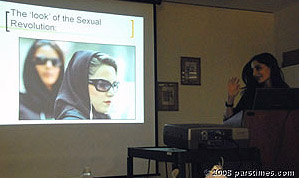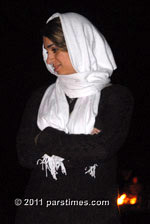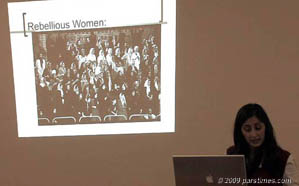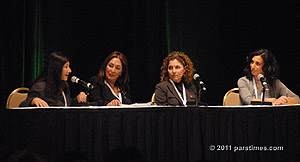

Hijab in post revolutionary Iran                                                    Women at the beach (1970s): Posed photo shows the differences between traditional and modern lifestyles in Iran during the Pahlavi Era. Now It's the Law! The hijab debate is a very complex issue and chances are that it won't be resolved in the near future. It's a political hot potato. The traditionalist and modernist are evenly divided on this issue. In fact, in secular countries like Tajikistan and Turkey there is a similar discourse. The founders of the revolution truly believed that it would be possible to create a just and pure society once we adopted Islamic values. They blamed mimicking the decadent West for many ills of Pahlavi Era. However, the cultural revolution failed to create the society that the intellectual clerics had in mind.  Iranian women were at the forefront of the revolution. They fought fiercely to end the tyranny of the monarchy. Their dream was about social justice and true equality. The strict Islamic dress code (hijab) became the law in 1980 despite large demonstrations by the women's groups. Now, it's almost impossible to reverse it. The dress code is very strict (maghna'eh or chador) for government employees but relaxed (loose scarf) for those who work in the private sector. Women in public places are required to wear little or no makeup and dress modestly. The law is often enforced by morality police. The government feels the need to prevent women from becoming promiscuous and fight the spread of sexually transmitted diseases. Furthermore, it aims at shedding the ugly Western image. The government role at times has been a tricky balancing act. The conservative and traditionalist (approximately 60% of adults) demand that women wear the chador and stay at home with kids. However, the government allows women to be active in all aspects of public life. But the catch is that those who wear a strict hijab get preferential treatment. Those who wear a loose scarf risk harassment and arrest if too much hair (subjective "gray" area) is shown. Thus the dress code causes inequality between different types of women. Finally, women are also allowed to participate in sporting events as long as they abide by Islamic rules, regulations and dress code. Overall, the government gets a passing grade but there is a lot of room for improvement. It should stress and promote Islam and modernity in order to survive.  It's noteworthy to mention that the tradition of wearing some form of head covering for women goes back to pre-Islamic Iran. The veil and the seclusion of women were adopted from the Assyrians. Yet, feminist groups have advocated for freedom of choice and for hijab to become a personal option. This idea requires government protection to work and may not work if the society is not ready for it. Besides, true gender equality does not exist anywhere in our region. Opponents argue violence against women may increase if the parliament changes the law on dress code. In fact, there is a lot harassment and violence against unveiled women in Pakistan where hijab is optional. Many women lead stressful and unhappy lives despite having more freedom. Women who defy social norms are routinely assassinated. Police cannot protect women from so many religious extremists. It's vital to take small steps and then monitor the situation. A workable compromise might be the dissolution of morality police which has been the worst PR nightmare for the government. Iran is perceived as a backward police state by the rest of the world because of constant harassment of ordinary citizens. Post-revolutionary Iran is first and formost a People's Republic. Let people to police themselves.  Hijab Videos Hijab Videos
|